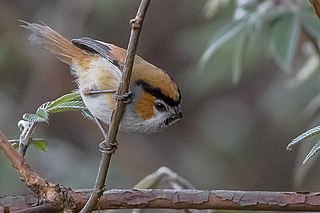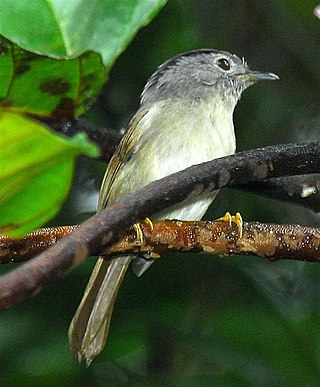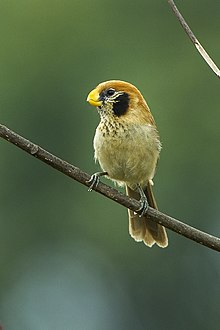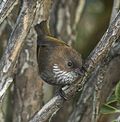
A passerine is any bird of the order Passeriformes which includes more than half of all bird species. Sometimes known as perching birds, passerines generally have an anisodactyl arrangement of their toes, which facilitates perching.
Old World warblers are a large group of birds formerly grouped together in the bird family Sylviidae. They are not closely related to the New World warblers. The family held over 400 species in over 70 genera, and were the source of much taxonomic confusion. Two families were split out initially, the cisticolas into Cisticolidae and the kinglets into Regulidae. In the past ten years they have been the subject of much research and many species are now placed into other families, including the Acrocephalidae, Cettiidae, Phylloscopidae, and Megaluridae. In addition some species have been moved into existing families or have not yet had their placement fully resolved. A smaller number of warblers, together with some babblers formerly placed in the family Timaliidae and the parrotbills, are retained in a much smaller family Sylviidae.

Sylviidae is a family of passerine birds that includes the typical warblers and a number of babblers formerly placed within the Old World babbler family. They are found in Eurasia and Africa.

The typical warblers are small birds belonging to the genus Sylvia in the "Old World warbler" family Sylviidae.

The Old World babblers or Timaliidae, are a family of mostly Old World passerine birds. They are rather diverse in size and coloration, but are characterised by soft, fluffy plumage. These are birds of tropical areas, with the greatest variety in Southeast Asia and the Indian subcontinent. The timaliids are one of two unrelated groups of birds known as babblers, the other being the Australasian babblers of the family Pomatostomidae.

The white-eyes are a family, Zosteropidae, of small passerine birds native to tropical, subtropical and temperate Sub-Saharan Africa, southern and eastern Asia, and Australasia. White-eyes inhabit most tropical islands in the Indian Ocean, the western Pacific Ocean, and the Gulf of Guinea. Discounting some widespread members of the genus Zosterops, most species are endemic to single islands or archipelagos. The silvereye, Zosterops lateralis, naturally colonised New Zealand, where it is known as the "wax-eye" or tauhou ("stranger"), from 1855. The silvereye has also been introduced to the Society Islands in French Polynesia, while the Japanese white-eye has been introduced to Hawaii.

The wrentit is a small bird that lives in chaparral, oak woodlands, and bushland on the western coast of North America. It is the only species in the genus Chamaea.

The ashy-throated parrotbill is a parrotbill. In old sources, it may be called Alphonse's crow-tit; though superficially resembling a tit it is not a member of the Paridae. The native range of this species extends from south-west China to northern Vietnam, and it might have become naturalised in one area in Italy.

Passerida is, under the Sibley-Ahlquist taxonomy, one of two parvorders contained within the suborder Passeri. While more recent research suggests that its sister parvorder, Corvida, is not a monophyletic grouping, the Passerida as a distinct clade are widely accepted.

The grey-headed parrotbill is a parrotbill in the family Sylviidae and is found in eastern Asia from the Himalayas to Indochina and Hainan.

The black-throated parrotbill is a parrotbill species often placed with the Old World babblers or in a distinct family Sylviidae, but it actually seems to belong to the distinct family Paradoxornithidae.

The rufous-headed parrotbill, or greater rufous-headed parrotbill, is a parrotbill in the family Paradoxornithidae and is found in eastern Asia from the eastern Himalayas to Indochina.

Pnoepyga is a genus of passerines endemic to southern and southeastern Asia. Its members are known as cupwings or wren-babblers. The genus contains four species. The genus has long been placed in the babbler family Timaliidae. A 2009 study of the DNA of the families Timaliidae and the Old World warblers (Sylviidae) found no support for the placement of the genus in either family, prompting the authors to erect a new monogeneric family, the Pnoepygidae.

The Beijing babbler, also known as the white-browed Chinese warbler, Chinese hill warbler, or Chinese bush-dweller, is a species of bird in the genus Rhopophilus. It is now thought to be a close relative of the parrotbills and is placed in the family Paradoxornithidae; previously, it was placed in the families Cisticolidae, Timaliidae or Sylviidae. It is found in northern China and North Korea, and formerly occurred in South Korea. The species was first described by Robert Swinhoe in 1868.

Sylvioidea is a superfamily of passerine birds, one of at least three major clades within the Passerida along with the Muscicapoidea and Passeroidea. It contains about 1300 species including the Old World warblers, Old World babblers, swallows, larks and bulbuls. Members of the clade are found worldwide, but fewer species are present in the Americas.

Alcippe is a genus of passerine birds in the monotypic family Alcippeidae. The genus once included many other fulvettas and was previously placed in families Pellorneidae or Timaliidae.

The white-breasted parrotbill is a bird species often placed with the Old World babblers or in a distinct family Paradoxornithidae, but it actually seems to belong to the Sylviidae.
The black-headed parrotbill is a bird species often placed with the Old World babblers or in the Sylviidae, but it actually seems to belong to the distinct family Paradoxornithidae.

The jungle babblers are a family, Pellorneidae, of mostly Old World passerine birds belonging to the superfamily Sylvioidea. They are quite diverse in size and coloration, and usually characterised by soft, fluffy plumage and a tail on average the length of their body, or longer. These birds are found in tropical zones, with the greatest biodiversity in Southeast Asia and the Indian subcontinent.












































